Charles E W Bean, Diaries, AWM38 3DRL 606/259/1 - 1917 - 1927 - Part 13


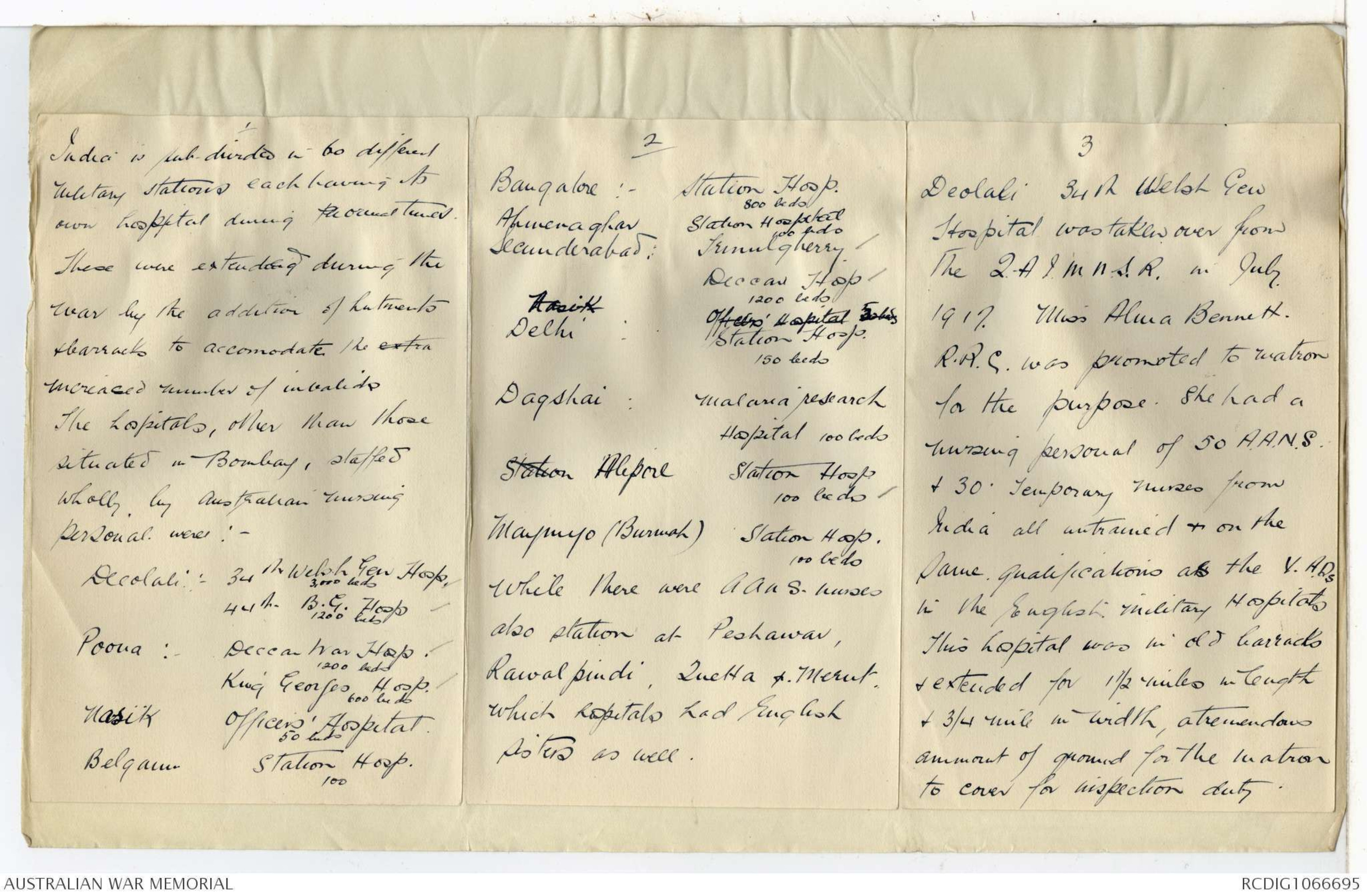
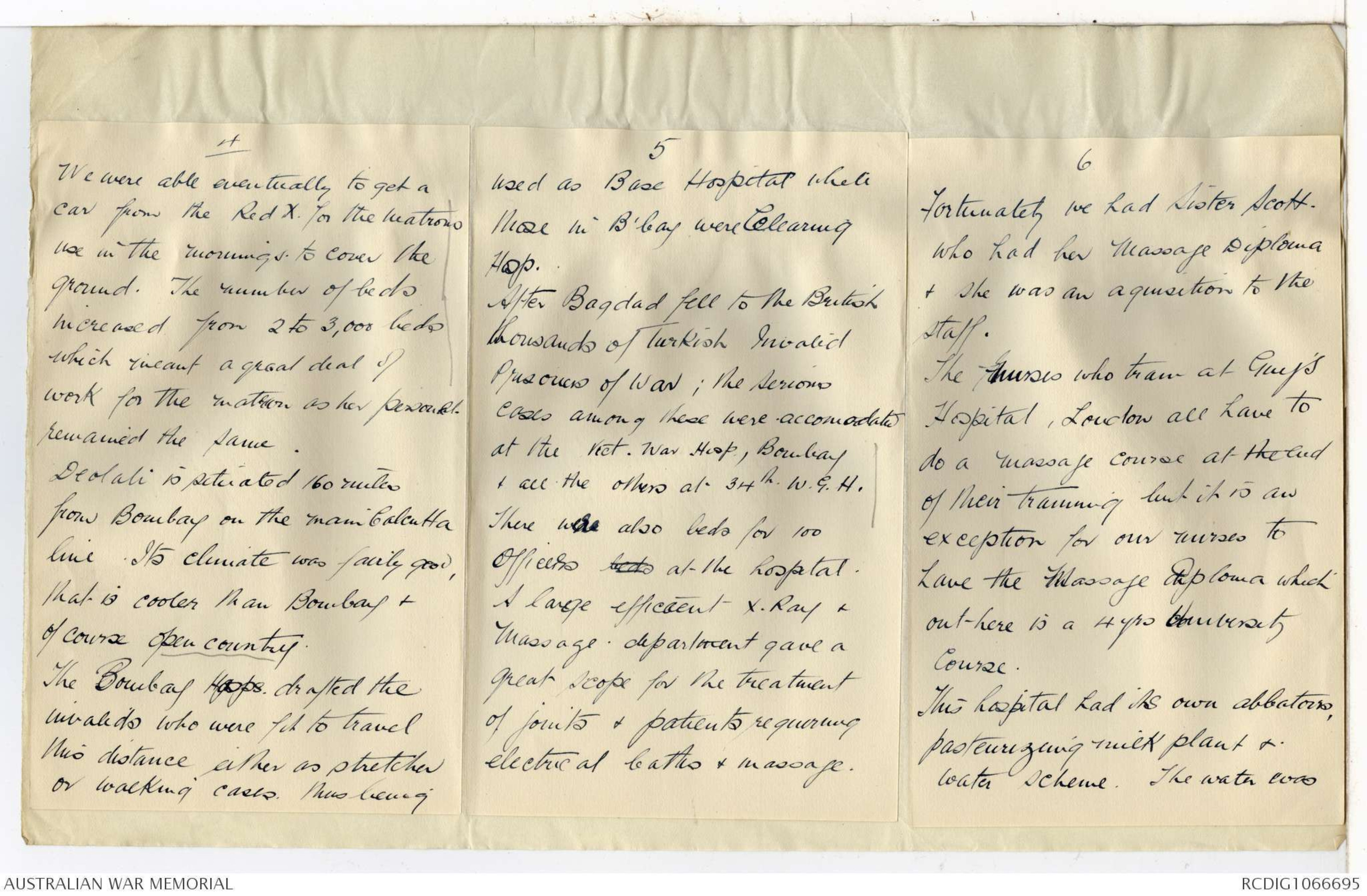
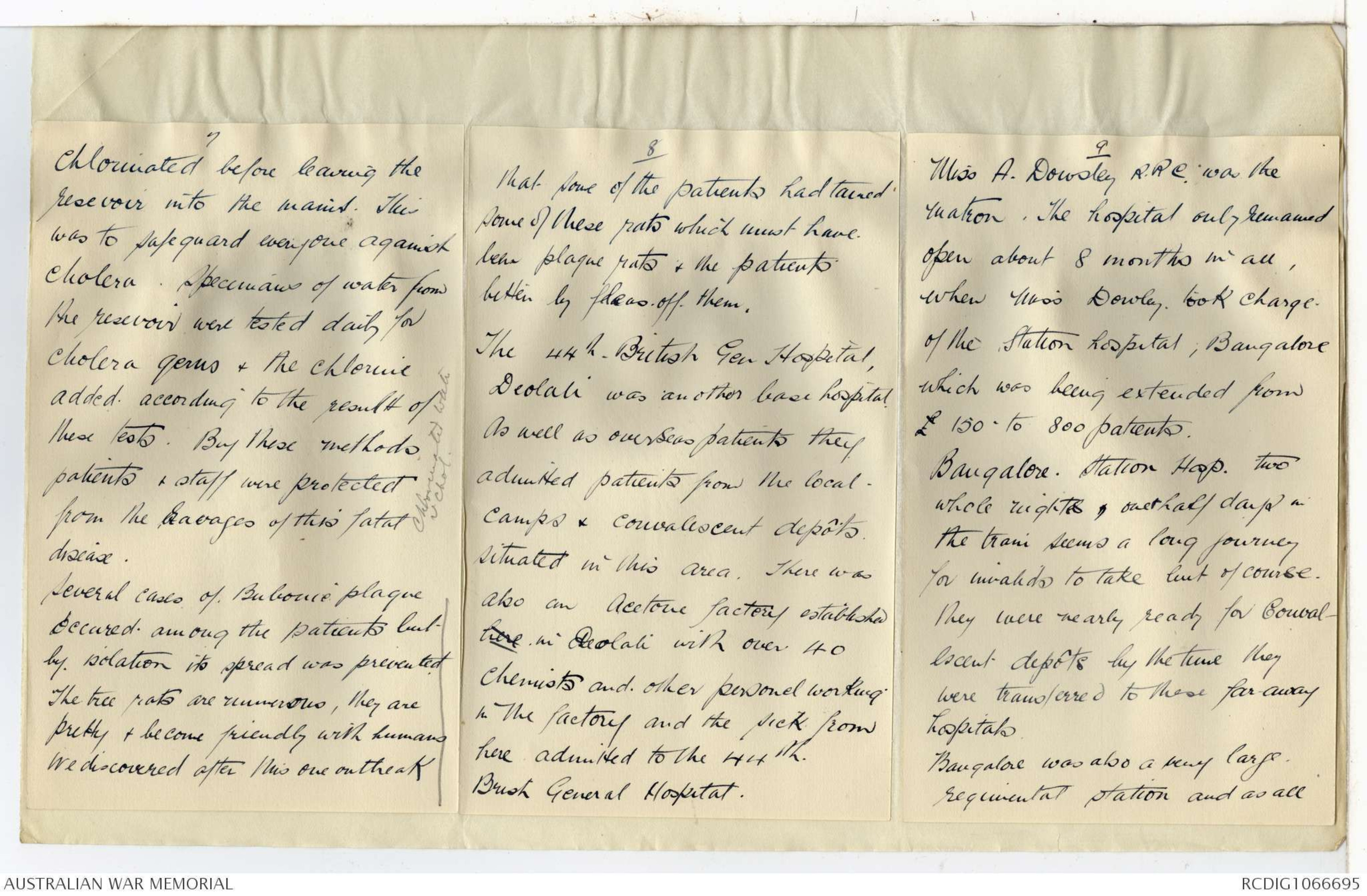
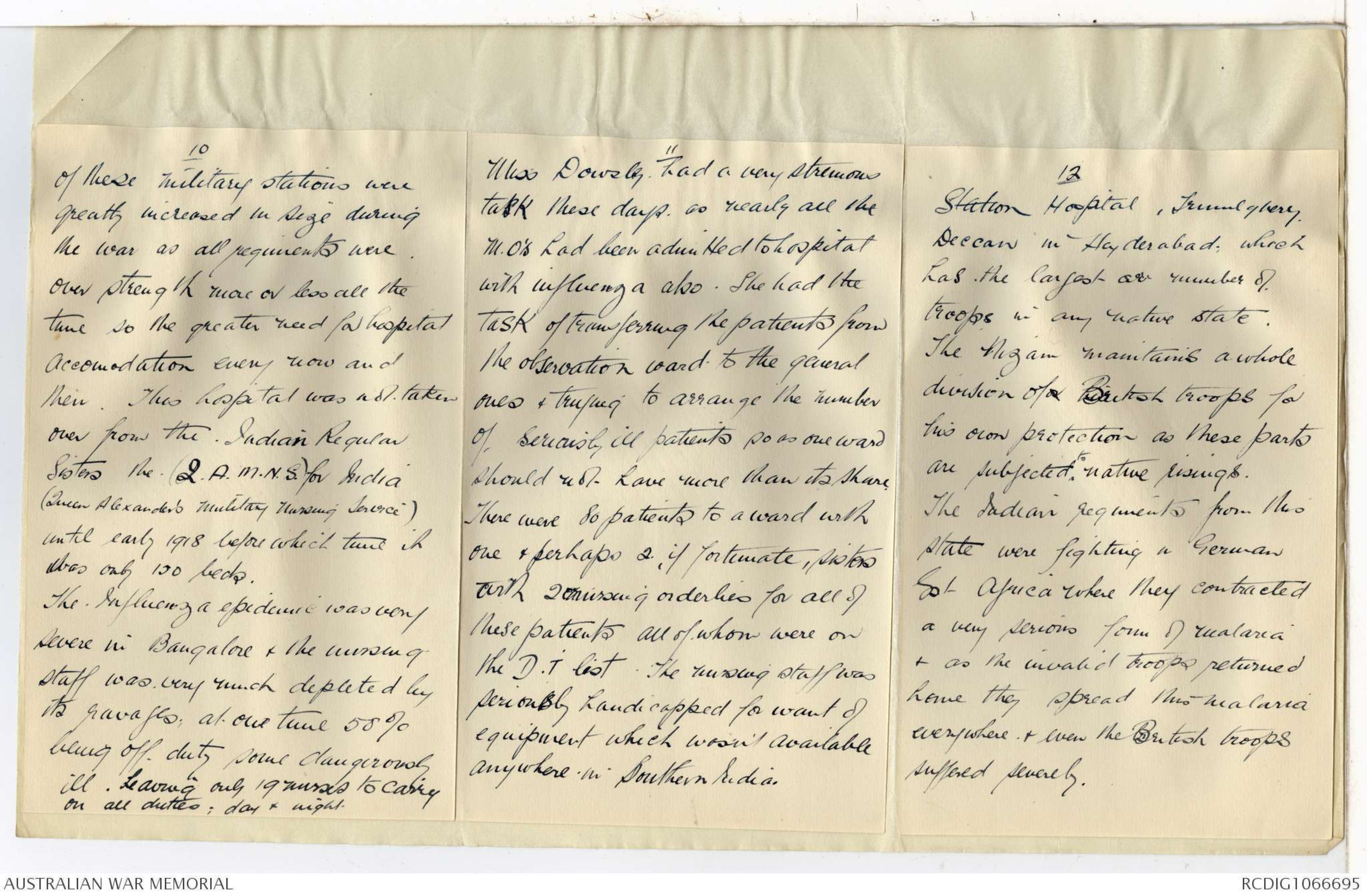
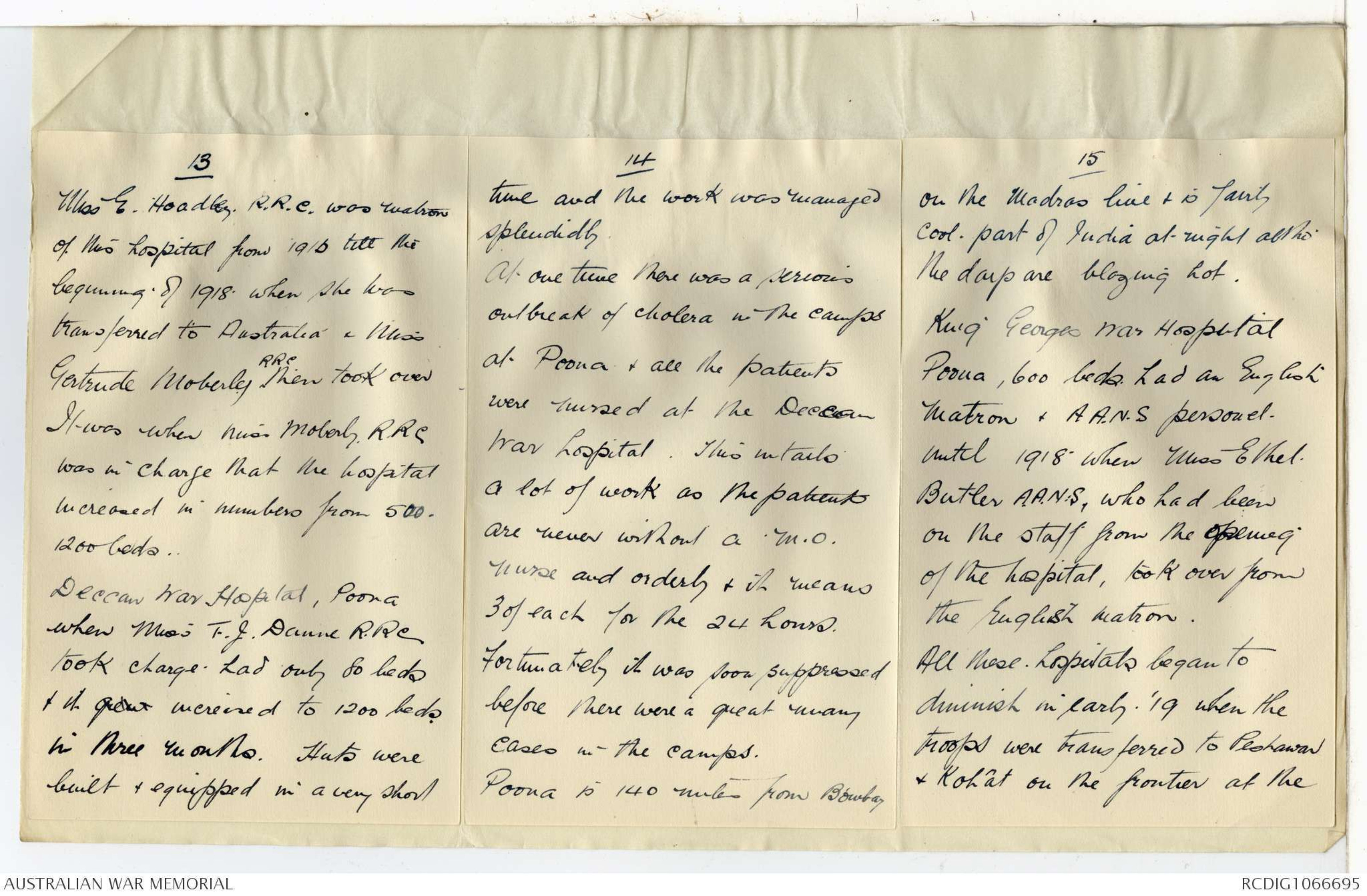
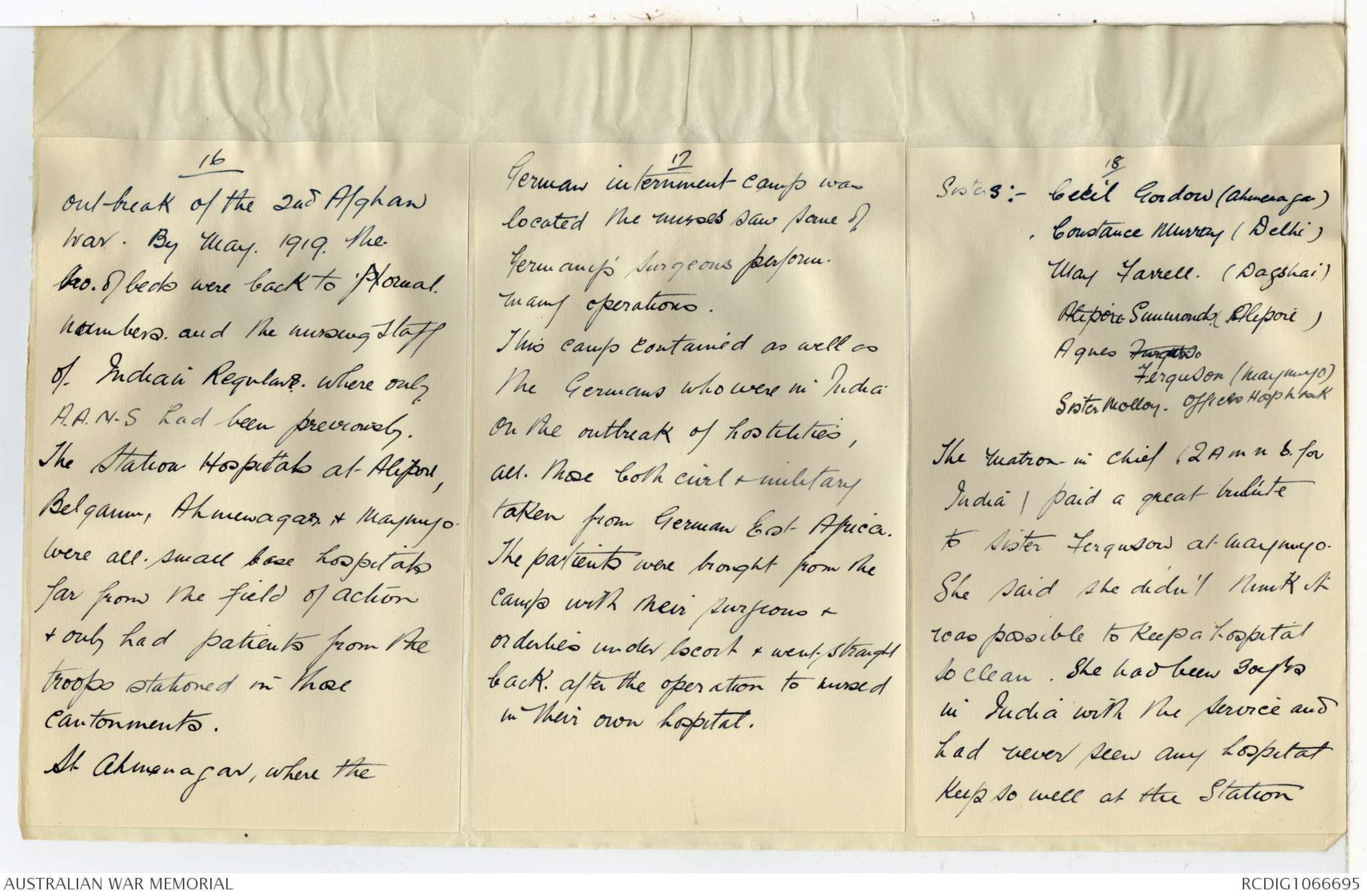
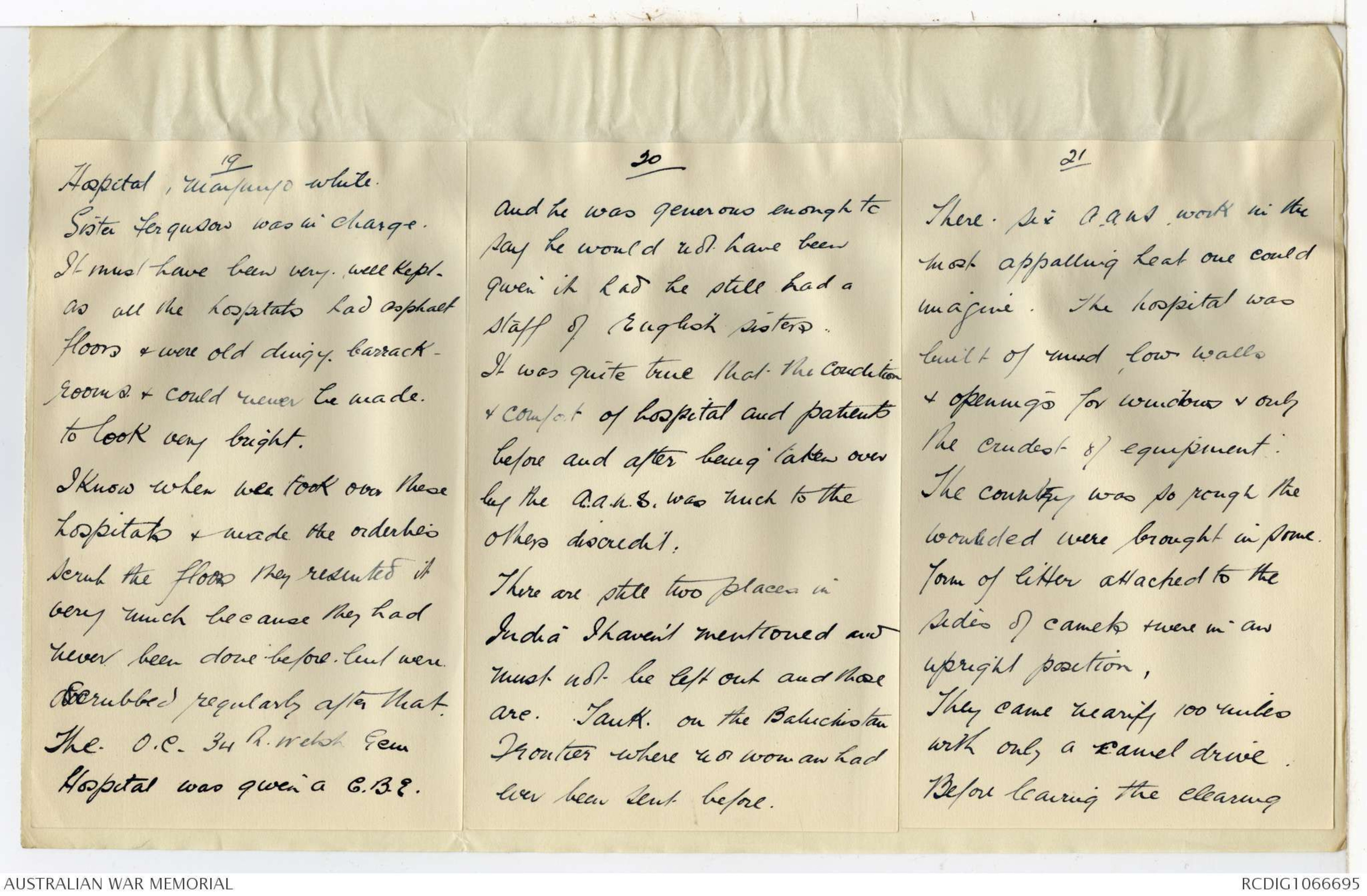

F.4151
xxxxxx
1460.
12 October 1926.
Matron G.E. Davies, R.R.C.,
209, Dandenong Road,
Windsor. Vic.
Dear Matron Davies,
I have to thank you very much for your kind promise
to contribute something about the Australian nurses in India
for the Mesopotamian unit history. The article can be short,
as the history has a good deal of space to cover. Its editor
is especially anxious to obtain, if he can, a nominal roll of
our nurses in India and Persia, as he is giving the roll of
all the rest of the force. If you have not such a roll for
the nurses, I will try to get it elsewhere. The editor is,
of course, desirous of publishing as soon as possible so as to
catch the Christmas sales.
With reference to photographs, we should be glad of
four or five good prints showing our nurses - preferably not
set groups taken by professional photographers. This, however,
is also a matter in which time has unfortunately to be considered,
since the plates take some preparation and have to be
printed early.
Yours sincerely,
C. E. W. BEAN
F.4151
xxxxxx
1449.
2 October 1926.
Matron G.E. Davies, R.R.C.,
209, Dandenong Road,
Windsor. Vic.
Dear Matron Davies,
The Mesopotamian units are trying to bring out before
Christmas a history of the Australians who served in the Eastern
campaigns, and are desirous of including an account of the service
of the Australian nurses in India. Several people have referred
to you as being the person who knows more about this than any
other. If you could see your way to write an account of that service,
our Mesopotamian comrades would be very grateful. I understand
that Australians even ran a hospital at Bushire in Persia;
the world in general knows nothing about this.
Do not worry about putting this account into a readable
form - that might take longer. If you would jot down, however
roughly, the facts and narrative, we will edit the material and,
if necessary, put it into shape.
I should be grateful if you would let me know whether
you could undertake this.
Yours faithfully,
C. E. W. BEAN
1
India is sub-divided in 60 different
Military stations each having its
own hospital during pnormal times.
These were extended during the
war by the addition of hutments
& barracks to accomodate the extra
increased number of invalids.
The hospitals, other than those
situated in Bombay, staffed
wholly by Australian nursing
personal were:-
| Deeolali:- | 34th Welsh Gen Hosp. |
3,000 beds |
√ |
| 44th B.G. Hosp |
1200 beds |
√ | |
| Poona:- | Deccan War Hosp. |
1200 beds |
√ |
| King Georges Hosp. |
600 beds |
√ | |
| Nasik | Officers' Hospital. |
50 beds |
|
| Belgaum | Station Hosp. |
100 |
2
| Bangalore:- | Station Hosp. |
800 beds |
|
| Ahmenaghar | Station Hospital |
100 beds |
|
| Secunderabad: | Trinulgherry |
|
√ |
| Deccan Hosp |
1200 beds |
√ | |
|
|
|||
| Delhi | Station Hosp. |
150 beds |
|
| Dagshai: | Malaria research Hospital |
100 beds |
|
| Station Hosp. |
100 beds |
√ | |
| Maymyo (Burmah) | Station Hosp. |
100 beds |
While there were AANS. nurses
also station at Peshawar,
Rawalpindi, Quetta & Merut.
which hospitals had English
Sisters as well.
3
Deolali 34th Welsh Gen
Hospital was taken over from
the Q.A.I.M.N.S.R. in July
1917. Miss Alma Bennett.
R.R.C. was promoted to matron
for the purpose. She had a
nursing personal of 50 A.A.N.S.
& 30 Temporary nurses from
India all untrained & on the
same qualifications as the V.A.Ds
in the English Military Hospitals
This hospital was in old barracks
& extended for 1½ miles in length
& ¾ mile in width, a tremendous
ammount of ground for the matron
to cover for inspection duty.
4
We were able eventually to get a
car from the Red X. for the matrons
use in the mornings to cover the
ground. The number of beds
increased from 2 to 3,000 beds
which meant a great deal of
work for the matron as her personnel
remained the same.
Deolali is situated 160 miles
from Bombay on the main Calcutta
line. Its climate was fairly good,
that is cooler than Bombay &
of course open country.
The Bombay Hosps. drafted the
invalids who were fit to travel
this distance either as stretcher
or walking cases. Thus being
5
used as Base Hospital while
those in B'bay were Clearing
Hosp.
After Bagdad fell to the British
thousands of Turkish Invalid
Prisoners of War; the serious
cases among these were accomodated
at the Vict. War Hosp, Bombay
& all the others at 34th W.G.H.
There were also beds for 100
Officers beds at the hospital.
A large efficient X.Ray &
massage department gave a
great scope for the treatment
of joints & patients requiring
electrical baths & massage.
6
Fortunately we had Sister Scott.
who had her Massage Diploma
& she was an aquisition to the
staff.
The nurses who train at Guy's
Hospital, London all have to
do a massage course at the end
of their training but it is an
exception for our nurses to
have the Massage Diploma which
out here is a 4yrs University
Course.
The hospital had its own abbatoirs,
pasteurizing milk plant &
water scheme. The water was
7
chlorinated before leaving the
reservoir into the mains. This
was to safeguard everyone against
cholera. Specimans of water from
the reservoir were tested daily for
cholera germs & the chlorine
added according to the result of
these tests. By these methods
patients & staff were protected
from the ravages of this fatal
disease.
[*Chlorinated water v chol.*]
Several cases of Bubonic plague
occured among the patients but
by isolation its spread was prevented.
The tree rats are numerous, they are
pretty & become friendly with humans
We discovered after this one outbreak
8
that some of the patients had trained
some of these rats which must have
been plague rats & the patients
bitten by fleas off them.
The 44th British Gen Hospital,
Deolali was another base hospital.
As well as overseas patients they
admitted patients from the local.
camps & convalescent depôts.
situated in this area. There was
also an Acetone factory establishedhere in Deolali with over 40
chemists and other personel working
in the factory and the sick from
here admitted to the 44th.
Brish General Hospital.
9
Miss A.Dowsley R.R.C. was the
matron. The hospital only remained
open about 8 months in all,
when Miss Dowsley took charge
of the Station hospital, Bangalore
which was being extended from£ 150 to 800 patients.
Bangalore Station Hosp. two
whole nights, one & half days in
the train seems a long journey
for invalids to take but of course
they were nearly ready for convalescent
depôts by the time they
were transferred to these far away
hospitals.
Bangalore was also a very large
regimental station and as all
10
of these military stations were
greatly increased in size during
the war as all regiments were
over strength more or less all the
time so the greater need for hospital
accomodation every now and
then. This hospital was not taken
over from the Indian Regular
Sisters the (Q.A.M.N.S) for India
(Queen Alexander's Military Nursing Service)
until early 1918 before which time it
was only 150 beds.
The Influenza epidemic was very
severe in Bangalore & the nursing
staff was very much depleted by
its ravages; at one time 58%
being off duty some dangerously
ill. Leaving only 19 nurses to carry
on all duties; day & night.
11
Miss Dowsley had a very strenuous
task these days as nearly all the
M.O's had been admitted to hospital
with influenza also. She had the
task of transferring the patients from
the observation ward to the general
ones & trying to arrange the number
of seriously ill patients so as one ward
should not have more than its share.
There were 80 patients to a ward with
one & perhaps 2, if fortunate, sisters
with 2 nursing orderlies for all of
these patients all of whom were on
the D.T list. The nursing staff was
seriously handicapped for want of
equipment which wasn't available
anywhere in Southern India.
12
Station Hospital, Trimulghery.
Deccan in Hyderabad, which
has the largest av number of
troops in any native state.
The Nizam maintains a whole
division ofor British troops for
his own protection as these parts
are subjected ^ to native risings.
The Indian regiments from this
state were fighting in German
Est Africa where they contracted
a very serious form of malaria
& as the invalid troops returned
home they spread this malaria
everywhere & even the British troops
suffered severely.
13
Miss E Hoadley R.R.C. was Matron
of this hospital from 1916 till the
beginning of 1918 when she was
transferred to Australia & Miss
Gertrude Moberley ^ RRC then took over
It was when Miss Moberly R.R.C
was in charge that the hospital
increased in numbers from 500 -
1200 beds.
Deccan War Hospital, Poona
when Miss T.J. Dunne R.RC
took charge had only 80 beds
& it grew increased to 1200 beds
in three months. Huts were
built & equipped in a very short
14
time and the work was managed
splendidly.
At one time there was a serious
outbreak of cholera in the camps
at Poona & all the patients
were nursed at the Deccan
War hospital. This intails
a lot of work as the patients
are never without a M.O.
nurse and orderly & it means
3 of each for the 24 hours.
Fortunately it was soon suppressed
before there were a great many
cases in the camps.
Poona is 140 miles from Bombay
15
on the Madras line & is fairly
cool part of India at night altho'
the days are blazing hot.
King Georges War Hospital
Poona, 600 beds had an English
Matron & A.A.N.S personel.
until 1918 when Miss Ethel
Butler A.A.N.S, who had been
on the staff from the opening
of the hospital, took over from
the English matron.
All these hospitals began to
diminish in early '19 when the
troops were transferred to Peshawar
& Kohât on the frontier at the
16
outbreak of the 2nd Afghan
War. By May 1919 the
no. of beds were back to pNormal
numbers and the nursing staff
of Indian Regulars where only
A.A.N.S had been previously.
The Station Hospitals at Alipore,
Belgaum, Ahmenagar & Maymyo
were all small base hospitals
far from the field of action
& only had patients from the
troops stationed in those
cantonments.
At Ahmenagar, where the
17
German internment camp was
located the nurses saw some of
Germany's surgeons perform
many operations.
This camp contained as well as
the Germans who were in India
on the outbreak of hostilities,
all those both civil & military
taken from German East Africa.
The patients were brought from the
camp with their surgeons &
orderlies under escort & went straight
back after the operation to nursed
in their own hospital.
18
Sisters:- Cecil Gordon (Ahmenagar)
Constance Murray (Delhi)
May Farrell (Dagshai)Alipore Simmonds (Alipore)
Agnes Farqhso Ferguson (Maymyo)
Sister Molloy. Officers Hosp Nasik
The matron-in chief (2 A M N S. for
India) paid a great tribute
to Sister Ferguson at Maymyo.
She said she didn't think it
was possible to keep a hospital
so clean. She had been 30yrs
in India with the Service and
had never seen any hospital
keep so well as the Station
19
Hospital, Maymyo while
Sister Ferguson was in charge.
It must have been very well kept
as all the hospitals had asphalt
floors & were old dingy barrack-
rooms & could never be made.
to look very bright.
I know when we took over these
hospitals & made the orderlies
scrub the floors they resented it
very much because they had
never been done before but were
scrubbed regularly after that.
The O.C 34th Welsh Gen
Hospital was given a C.B.E
20
and he was generous enough to
say he would not have been
given it had he still had a
staff of English sisters.
It was quite true that the condition
& comfort of hospital and patients
before and after being taken over
by the A.A.N.S. was much to the
others discredit.
There are still two places in
India I haven't mentioned and
must not be left out and those
are Tauk. on the Baluchistan
Frontier where no woman had
ever been sent before.
21
There six A.A.N.S work in the
most appalling heat one could
imagine. The hospital was
built of mud, low walls
& openings for windows & only
the crudest of equipment.
The country was so rough the
wounded were brought in some
form of litter attached to the
sides of camels & were in an
upright position.
They came wearily 100 miles
with only a camel drive.
Before leaving the Clearing
22
Station their water bottle was
filled, they were given hard
rations of bully & biscuit 24 hrs
supply, & came in always in
a state of exhaustion.
Fortunately the aeroplanes soon
finished this frontier war & they
were all able to leave.
The sisters had a picket of 12
Gurkhas always round their
bungalow.
The Gen. called personally on me
to extoll the praises of our nurses
in Tauk & said what a great
difference it made to the sick &
23
wounded to have them there. If the
women folk could stick it out
well so could they.
Sister E.G. Browne A.R.R.C. was
in charge with Sister Vera Steel
also A.R.R.C as assistant
Then they had staff nurses:-
Elsie Jack
- McAllister
Dora Furness
Emily Rogers
Dera-Gaza-Khan was the other
small frontier war where we
sent three sisters: Sister E Horne ARRC
- Beryl Tucker
Hodgson
24
This was not quite such an awful
place as Tauk but was nearly
the last place God made -
Tauk was.
May 1919. when we had closed
all our hospitals & were hoping
to embark for Australia the
Second Afghan war commenced
& many of us were transferred
to Rawal Pindi, Gharial -
and Khuldana.
All population except military
was forced to leave Peshawar &
Kohat, even Officers' wives &
 Peta
PetaThis transcription item is now locked to you for editing. To release the lock either Save your changes or Cancel.
This lock will be automatically released after 60 minutes of inactivity.